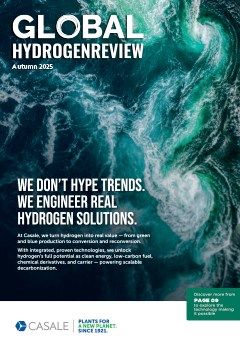Editorial comment
The latest edition of the International Energy Agency’s (IEA) annual report that tracks hydrogen production and demand worldwide, as well as progress in critical areas such as infrastructure development, trade, policy, regulation, investments and innovation, was released in September 2025.1 The report notes that worldwide hydrogen demand increased to almost 100 million t in 2024, up 2% from 2023. Against this backdrop, it is forecast that low-emissions hydrogen production is set to see robust growth to 2030, though at a slower pace than originally hoped.
Register for free »
Get started now for absolutely FREE, no credit card required.
The IEA’s analysis of announced projects suggests that low-emissions hydrogen production has the potential to reach 37 million tpy by 2030, down from a potential of 49 million tpy based on projects announced a year earlier. Uptake of low-emissions projects is not meeting expectations set by industry and governments, with growth restrained by high costs, demand and regulatory uncertainty, and slow infrastructure development.
Of course, and as is evidenced by the drop in figures noted above, not all projects that are announced come to fruition, so actual capacity is likely to be significantly lower. Despite this, the IEA expects that projects that are either operational, under construction, or have reached final investment decision (FID) by 2030 will increase fivefold from 2024 levels to more than 4 million tpy, with strong potential for an additional 6 million tpy if effective policies are implemented.
IEA Executive Director, Fatih Birol, said: “The latest data indicates that the growth of new hydrogen technologies is under pressure due to economic headwinds and policy uncertainty, but we still see strong signs that their development is moving ahead globally. To help growth continue, policy makers should maintain support schemes, use the tools they have to foster demand, and expedite the development of necessary infrastructure.”
As Nel Hydrogen explains in an article starting on page 15 of this issue, nothing that is worth doing ever comes easy. The article’s author, Håkon Volldal, uses Thomas Edison and Steve Jobs as examples of pioneers who revolutionised electric lighting and the tech industry, respectively, despite being met with significant challenges and scepticism from peers, the public, and investors. However, both men’s determination and unwavering belief in their vision led them to persevere through the obstacles and transform the way that millions of us live our lives. Volldal says: “Hydrogen engineers and producers are at the forefront of the industry, anyone pursuing hydrogen as a renewable energy source is a pioneer. Yes, there are plenty of challenges in the hydrogen market [...] However, the risk and investment that people and companies are taking will be worth it. Like Thomas Edison, early movers in hydrogen will benefit from a faster learning curve. Like Apple, companies, alongside customers, will reap the benefits of industry leadership and brand loyalty. Most importantly, hydrogen companies will start the movement towards a cleaner world which will have a significant positive impact for the next generation.” Volldal encourages all of our readers to “stay the course” and help pioneer a cleaner future for generations to come.
If you are picking up a copy of this issue of Global Hydrogen Review at the Hydrogen Technology World Expo in Hamburg, I’d encourage you to register for a free subscription to the magazine by visiting www.globalhydrogenreview.com/magazine. We’ll also be hosting our annual virtual Global Hydrogen Conference on 3 December 2025. Whether you are able to attend live or would prefer to watch on-demand, you can sign up for a free pass by visiting: www.accelevents.com/e/Global-Hydrogen-Conference-2025


